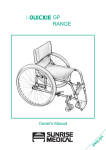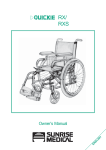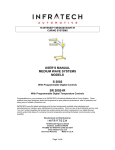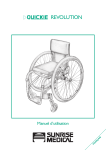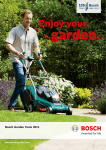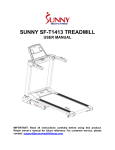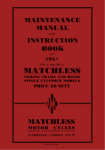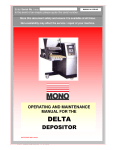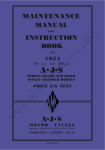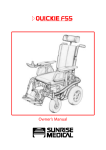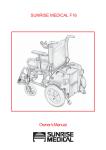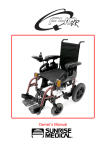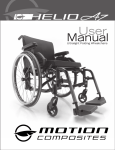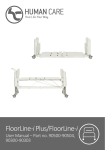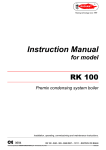Download BREEZY - John Preston Healthcare Group
Transcript
BREEZY Owner’s Manual SH LI G EN Breezy 48 21.06.2010 Rev.9 BREEZY How to use this manual We at Sunrise Medical want you to get the best out of your Breezy wheelchair. This Owner’s Manual will familiarise you with the chair and its features. It contains hints on everyday usage and general care in addition to information on the high quality standards which we adhere to and details about the guarantee. This manual gives information on all features without stating whether they are optional or standard. For this information refer to the order/prescription form or your prescriber/supplier. Your wheelchair will reach you in excellent condition having been personally inspected before leaving our factory. By following the guidelines for maintenance and cleaning on pages 32-33 your wheelchair will maintain its first class condition and give you complete satisfaction. The Breezy wheelchair can easily be converted to a transit (TL) wheelchair and vice versa by changing the axle plate, axles and rear wheels. We recommend that you contact your local wheelchair supplier/prescriber to carry out this conversion. For ease of use Warning denotes a risk of personal injury or damage to your chair and Ö indicates points which will improve the performance and safety of your chair. Issue 6 Breezy Contents Introduction page 1 Guarantee page 2 Features and options page 3 Safety tips page 4 - 7 Using your chair page 8 - 19 Footrests page 20 Legrests page 21 Armrests page 22 - 23 Wheel locks page 24 Anti-tip tubes and quick-release axles page 25 Chair adjustments page 26 - 30 Lap belt instructions page 31 - 32 Transportation page 33 - 36 Maintenance schedule page 37 Cleaning guidelines, accessories and tools page 38 Technical data page 39 Sunrise Medical page 40 21.06.2010 Rev.9 47 Breezy Introduction Sunrise is dedicated to providing products of exacting quality which conform fully and reliably to the requirements of their intended use. This wheelchair is to be used to aid individuals with limited or no personal mobility. The Breezy is suitable for both indoor and outdoor use. The maximum user weight for this chair is 125kg (275lb). Sunrise is accredited to BS EN ISO 9001, which is the internationally recognised standard for quality management systems. This approval ensures we provide quality in all areas of our business from development through to final delivery. As the manufacturer, SUNRISE MEDICAL, declares that the lightweight wheelchairs conform to the 93/42/EEC / 2007/47/EEC guideline. IMPORTANT: DO NOT USE YOUR WHEELCHAIR UNTIL THIS MANUAL HAS BEEN READ AND UNDERSTOOD. If you have any queries about the use, maintenance or safety of your wheelchair please contact your wheelchair prescriber/supplier. Sunrise Medical will be pleased to answer any other questions that you may have and can provide a list of approved Sunrise Medical agents on request to: SUNRISE MEDICAL LIMITED HIGH STREET WOLLASTON WEST MIDLANDS DY8 4PS ENGLAND Telephone 01384 44 66 88 Fax. 01384 44 66 99 International Telephone +44 1384 44 66 88 Fax.+44 1384 44 66 99 www.sunrisemedical.co.uk Serial Number: Inspected by: Your local dealer: Your local dealer: 21.06.2010 Rev.9 1 Breezy Guarantee 7 Items of a consumable nature will not normally be covered during the 12 month warranty period unless such items have suffered undue wear as a direct result of an original manufacturing defect. These items include amongst others, lubricants, motor brushes, upholstery, tyres, inner tubes, pushhandle foam, brakes and similar parts. Batteries will be covered by the warranty only where they have been charged and maintained fully in accordance with the manufacturer’s recommendations. Your guarantee The guarantee form is included in the Sunrise Pack, which accompanies the chair on delivery. Please fill in the relevant details and return to us to register your entitlement. The guarantee is for your information. THIS IN NO WAY AFFECTS YOUR STATUTORY RIGHTS. Sunrise Medical guarantees the frame, crossbrace and wheelaxles on Breezy wheelchairs against defects in materials and workmanship for the lifetime of the original purchaser. 8 Under normal circumstances no responsibility will be accepted where the goods have required repair or replacement as a direct result of: All Breezy wheelchairs, parts and components (including frame components, axle plates, castors, armrest, backrests etc.) are guaranteed against defects in materials and workmanship for one year from purchase date. a) The goods or part not having been maintained in accordance with the manufacturer’s recommendations, where such exist and using only the specified original equipment parts. b) The goods or part having been damaged by neglect, accident or improper use. Warranty conditions c) The goods or part having been altered from the manufacturer’s specifications, or repairs having been attempted prior to the designated repairer being notified. 1 This warranty does not affect the statutory rights of the Customer but if the Customer wishes to have the benefit of the Company’s warranty the Customer must comply with the provisions set out below. 2 In the event of a defect in the goods supplied becoming apparent within the warranty period which commences from the delivery date the Company either itself or by an authorised dealer repair agent will effect any necessary repair or replacement of parts free of charge on condition that the Customer complies with the following provisions of this warranty. 3 Any part repaired or replaced during the warranty period is warranted for the remainder of the duration of that period. 4 The arrangements for repairs and service and the designated repairer will be notified to the Customer by the Company and will be confirmed at any time on request. d) Fair wear and tear. Please keep a note of your local service agent’s address and telephone number in the space provided on the previous page. In the event of a breakdown, contact them and try to give all relevant details so they can help you quickly. The wheelchairs shown and described in this manual may not be exactly the same in every detail as your own model. However, all instructions are still entirely relevant, irrespective of detail differences. The manufacturer reserves the right to alter without notice any weights, measurements or other technical data shown in this manual. All figures, measurements, and capacities shown in this manual are approximate, and do not constitute specifications. 5 ON A DEFECT OCCURRING DURING THE WARRANTY PERIOD THE CUSTOMER MUST NOTIFY THE DESIGNATED REPAIRER IMMEDIATELY GIVING FULL INFORMATION AS TO THE PROBLEM AND NO USE MUST BE MADE OF THE GOODS AND NO ALTERATION OR UNAUTHORISED REPAIRS MADE TO THE GOODS PRIOR TO INSPECTION BY THE DESIGNATED REPAIRER. Please remember to fill in and post the guarantee registration card enclosed with this manual. Sunrise Medical Limited recommend that you do not undertake maintenance tasks other than those explained in this manual. Your local approved Sunrise Medical service agent is fully trained by Sunrise Medical to carry out detailed maintenance as and when required. Use only genuine Sunrise Medical replacement parts. 6 If the Customer is operating the Goods away from the locality of the designated repairer the Customer must contact the Company to obtain the name and address of another repairer authorised by the Company. If the Customer is operating the Goods outside the UK the Customer must bear the transport, insurance and packaging costs incurred in having the Goods repaired or replaced by an authorised repairer of the Company. Sunrise Medical Limited High Street, Wollaston, West Midlands DY8 4PS England Tel 01384 44 66 88 Fax 01384 44 66 99 www.sunrisemedical.co.uk Breezy 2 21.06.2010 Rev.9 Features and options 2 1 3 4 14 5 13 12 6 11 1 2 3 4 5 6 7 10 9 Flip back armrest Push handle backrest tube Backrest upholstery Aluminium handrim Pneumatic tyre 6 spoke mag wheel Quick-release axles 21.06.2010 Rev.9 8 9 10 11 12 13 14 3 8 7 Wheel lock Crossbrace Castor fork/wheel assembly Swing away release lever Flip up footplate Swing-away hanger Seat sling Breezy Safety tips General safety notes and driving restrictions Use Lightweight wheelchairs are exclusively for a user who is unable to walk or has limited mobility, for their own personal use in- and outdoor. The maximum weight limit (includes both the user and any weight of accessories fitted to the wheelchair) is marked on the serial number label, which is affixed to the crossbar or stabiliser bar below the seat. Warranty can only be taken on if the product is used under the specified conditions and for the intended purposes. The intended lifetime of the wheelchair is 5 years. Please DO NOT use or fit any 3rd party components to the wheelchair unless they are officially approved by Sunrise Medical. The engineering and construction of this wheelchair has been designed to provide maximum safety. International safety standards currently in force have either been fulfilled or exceeded in parts. Nevertheless, users may put themselves at risk by improperly using their wheelchairs. For your own safety, the following rules must be strictly observed. Unprofessional or erroneous changes or adjustments increase the risk of accident. As a wheelchair user, you are also part of the daily traffic on streets and pavements, just like anyone else. We would like to remind you that you are therefore also subject to any and all traffic laws. Be careful during your first ride in this wheelchair. Get to know your wheelchair. Area of application The variety of fitting variants as well as the modular design mean that it can be used by those who cannot walk or have limited mobility e.g. because of: • Paralysis • Loss of extremity (leg amputation) • Extremity defect deformity • Joint contractures/joint injuries • Illnesses such as heart and circulation deficiencies, disturbance of equilibrium or cachexia as well as for elderly people who still have strength in the upper body. When considering provision, please also note the body size, weight, physical and psychological constitution, the age of the person, living conditions and environment. Before each use, the following should be checked: • Quick-release axles on the rear wheels • Velcro on seats and backrests • Tyres, tyre pressure and wheel locks. Before changing any of the adjustments of this wheelchair, it is important to read the corresponding section of the user’s manual. It is possible that potholes or uneven ground could cause this wheelchair to tip over, especially when riding uphill or downhill. When riding over a step or up an incline frontally, the body should be leaning forward. Danger! NEVER exceed the maximum load of 125 kg for driver plus any items carried on the wheelchair. If you exceed the maximum load, this can lead to damage to the chair, or you may fall or tip over, lose control and Breezy 4 21.06.2010 Rev.9 Danger! may lead to serious injury of the user and other people. With extreme settings (e.g. rear wheels in the most forward position) and less than perfect posture, the wheelchair may tip over even on a level surface. Danger! When it is dark, please wear light clothing or clothing with reflectors, so that you can be seen more easily. Make sure that the reflectors on the side and back of the wheelchair are clearly visible. We would also recommend that you fit an active light. Danger! Lean your upper body further forward when going up slopes and steps. Danger! Danger! Lean your upper body further back when going down slopes and steps. Never try to climb and descend a slope diagonally. To avoid falls and dangerous situations, you should first practice using your new wheelchair on level ground with good visibility. Danger! Avoid using an escalator which may lead to serious injury in the event of a fall. Danger! When getting on or off the wheelchair, do not use the footboards. These should be flipped up beforehand and swung to the outside as far as possible. Always position yourself as close as possible to the place where you wish to sit. Danger! Do not use the wheelchair on slopes > 10°. The Dynamic safe slope is dependant on the chair configuration, the users abilities and the style of riding. As the users abilities and style of riding cannot be predetermined then the max safe slope cannot be determined. Therefore this must be determined by the user with the assistance of an attendant to prevent tipping. It is strongly recommended that inexperienced users have Ant-tips fitted. Danger! Only use your wheelchair properly. For example, avoid travelling against an obstacle without braking (step, kerb edge) or dropping down gaps. Danger! Danger! The wheel locks are not intended to brake your wheelchair. They are only there to ensure that your wheelchair does not begin rolling unintentionally. When you stop on uneven ground, you should always use the wheel locks to prevent such rolling. Always apply both wheel locks; otherwise, your wheelchair could tip over. It is possible that potholes or uneven ground could cause this wheelchair to tip over, especially when riding uphill or downhill. Danger! Do not use your wheelchair on muddy or icy ground. Do not use your wheelchair where pedestrians are not allowed. Danger! Explore the effects of changing the centre of gravity on the behaviour of the wheelchair, for example on inclines, slopes, all gradients or when overcoming obstacles. Do this with the secure aid of a helper. 21.06.2010 Rev.9 Danger! To avoid hand injuries do not grab in between the spokes or between the rear wheel and wheel lock when driving the wheelchair. 5 Breezy In particular when using lightweight metal handrims, fingers will easily become hot when braking from a high speed or on long inclines. designed safety system, lightweight wheelchairs can be used as a seat when being transported in a specially fitted vehicle. (See the Chapter on “Transportation”). Danger! Danger! Only attempt stairs with the help of an attendant. There is equipment available to help you, e.g. climbing ramps or lifts, please use them. If there is no such equipment available, then the wheelchair must be tipped and pushed, never carried, over the steps (2 helpers). We recommend that users over 100 kg in weight do not use this stairway manoeuvre! Depending on the diameter and setting of the castors, as well as the centre of gravity setting of the wheelchair, the castors may begin to wobble at high speeds. This can lead to the castors being blocked and the wheelchair may tip over. Therefore, please make sure that the castors are adjusted correctly (see the Chapter “Castors”). In particular, do not travel on an incline without brakes, travel at a reduced speed. We recommend that novice users use antitip tubes. Danger! In general, any anti-tip tubes fitted must be set beforehand, so that they cannot touch the steps, as otherwise this could lead to a serious tumble. Afterwards the anti-tip tubes must be set back to their correct position. Danger! Anti-tip tubes should prevent the chair tipping over backwards unintentionally. Under no circumstances should they take the place of transit wheels, and be used to transport a person in a wheelchair with the rear wheels removed. Danger! Make sure that the attendant only holds the wheelchair using securely mounted parts (e.g. not on the footrests or the sideguards). Danger! When reaching for objects (which are in front of, to the side or behind the wheelchair) make sure that you do not lean too far out of the wheelchair, as if you change the centre of gravity there is a risk of tipping or rolling over. The hanging of additional load (back pack or similar items) onto your chair backposts can affect the rearward stability of your chair, especially when used in combination with recliner backrests. This can cause the chair to tip backwards causing injury. Danger! When using the lifting ramp make sure that the anti-tip tubes fitted are positioned outside the danger area. Danger! Secure your wheelchair on uneven ground or when transferring (e.g. into a car) by using the brakes. Danger! If and whenever possible, during a journey in a specially fitted vehicle for disabled people, vehicle occupants should use the seats in the vehicle and the appropriate restraint system. This is the only way to ensure that occupants will have the maximum protection if there is an accident. When using safety elements offered by SUNRISE MEDICAL and using a specially Breezy Danger! For thigh amputees you must use anti-tip tubes. Danger! Before setting off, check that your tyre pressure is correct. For rear wheels it 6 21.06.2010 Rev.9 Note ! should be at least 3.5 bar ( 350 kPa). The max. pressure is indicated on the tyre. The knee-lever brakes will only work if there is sufficient tyre pressure and if the correct setting has been made (see the Chapter on “Brakes”). Always be careful with your fingers when working or adjusting the wheelchair! The products shown and described in this manual may not be exactly the same in every detail as your own model. However, all instructions are still entirely relevant, irrespective of detail differences. Danger! If the seat and back sling are damaged, you must replace them immediately. The manufacturer reserves the right to alter without notice any weights, measurements or other technical data shown in this manual. All figures, measurements and capacities shown in this manual are approximate and do not constitute specifications. Danger! Be careful with fire, in particular with burning cigarettes. Seat and back slings can be set alight. Danger! If the wheelchair is subject to direct sunlight for a long period of time, then parts of the wheelchair (e.g. frame, legrests, brakes and sideguard) may become hot (>41°C). Danger! Always make sure that the quick-release axles on the rear wheels are set properly and lock in. If the button on the quickrelease axle is not pressed in, the rear wheel cannot be removed. Note ! The effect of the knee-lever brake as well as the general driving characteristics are dependant on tyre pressure. The wheelchair is significantly lighter and easier to manoeuvre when the rear wheels are pumped up correctly and both wheels have the same pressure. Note ! Make sure that your tyres have sufficient tread! Please note that you are subject to any and all traffic laws when driving in public traffic. 21.06.2010 Rev.9 7 Breezy Using your chair Opening Tilt the wheelchair towards you far enough to take the weight off the opposite wheel (Fig. 1). Push down with the palm of the hand on the seat rail (1) closest to you until the wheelchair has completely opened. Allow the chair to return to an upright position on all four wheels. Complete the opening procedure by now standing in front of the chair, placing the palms of your hands on both seat rails, and pressing down making sure the seat rail snaps into the rail saddles (2). Warning: 1 2 Do not place your fingers between the seat sling and frame rail during this operation. Fig. 1 Folding Flip up the footplates (Fig. 2) to a vertical position before folding the wheelchair. Standing to one side of the chair, reach down and grasp the seat sling at both the front and the back between your hands. Lift sharply to disengage the seat sling rails from their frame saddles. Once disengaged continue with an upward lift until the wheelchair is completely folded. Fig. 2 Breezy 8 21.06.2010 Rev.9 Using your chair Water, snow and ice 3. Always use good posture and proper body mechanics. When you lift or support the rider or chair, bend your knees slightly and keep your back as upright and straight as you can. 4. Unlock and rotate anti-tip tubes up out of the way, to avoid a trip or fall, when operating the chair from the back. 5. Always lock the rear wheels and lock anti-tip tubes in the down position if you must leave the rider alone, even for a moment. Doing so will reduce the risk of a tip over or loss of control of the chair. Contact with water, snow or ice may affect the performance of your wheelchair. 1. Never use your wheelchair in a pool or other body of water. 2. If your chair becomes wet, or if you use water to clean it, dry the chair thoroughly as soon as you can. When you need assistance Warning: If you fail to heed the following warnings, a fall or tip over may occur and cause severe injury to you or to your attendant. Centre of balance For the Rider: You should make sure that persons who assist you, read and follow all warnings and instructions that apply to that use. Before using this chair each attendant must know what to do to ensure safety. Warning: The point where this chair will tip forwards, backwards or to the side depends on its centre of balance and stability. If you fail to heed these warnings a fall or tip over may occur and cause severe injury to you: For Attendants: 1. Put the rider at ease. Tell the rider what you plan to do and explain what you expect the rider to do. 2. Work with the rider’s doctor, nurse or therapist to learn safe methods best suited to your abilities and those of the rider. 21.06.2010 Rev.9 1. The most important adjustment to your chair is the position of the rear axles. The further you move the rear axles forward, the better the chair manoeuvres, but the more likely it is that your chair will tip over backwards. Ö Consult your doctor, nurse or therapist to find out what axle position is best for you. 9 Breezy Using your chair Dressing and changing clothes Centre of balance (continued) 2. Changing the setup of this chair increases the risk of a fall or tip over. Be very careful if you make a change to any of the following: Ö The position of the rear axles, the distance between the rear wheels or the amount of rear wheel camber. Ö The distance between the centre of the front castors and rear wheels and the angle of the castors. 3. To avoid a fall or tip over you should: Ö Have someone help you until you know the balance points of your chair and how to avoid a tip over. Ö Use anti-tip tubes until you are sure you are not at risk of tipping over. 4. The centre of balance and stability of your chair are also affected by: Ö A shift in your body position, posture or weight distribution. Ö Riding your chair on a sloped surface. Ö Fitted seating systems. Warning: Your weight may shift if you dress or change clothes while seated in this chair. This may cause a fall or tip over and severe injury to you. To help prevent this you should: 1. Rotate the front castors to the forward position. 2. Lock anti-tip tubes in the down position if your chair has anti-tip tubes. 3. Back your chair up against a wall and lock both rear wheels. Refer to the sections that follow to learn how you can reduce the risk of a fall or tip over by proper use of this chair. Breezy 10 21.06.2010 Rev.9 Using your chair Wheelies (rear wheel balance) Follow these steps when learning to do a wheelie with help: A wheelie is performed by balancing on the rear wheels of your chair, while the front castors are raised off the ground. If done safely, it can help you overcome kerbs and other obstacles. 1. The attendant should be at the rear of the chair, and must be able to move with the chair to prevent a tip over. 2. The attendant’s hands should be beneath the push handles or back brace ready to catch you if you tip too far backwards. 3. When the attendant is in position, place your hands on the forward area of the handrims. 4. Make a quick backward movement of the rear wheels, immediately followed by a hard forward thrust. This will tilt the chair backwards and lift the castors from the ground. Try to find the balance point, which is the point where you will not fall backwards or forwards. 5. Maintain your balance by small movements of the handrims. Warning: It is dangerous to do a wheelie, as you may fall or tip over backwards and suffer a severe injury. Make sure that you heed these warnings: 1. Consult your doctor, nurse or therapist to find out if you are a good candidate to learn to do a wheelie. 2. Do not try to do a wheelie unless you are a highly skilled rider or unless you have help. 3. Make sure that anti-tip tubes are up, out of the way, so they do not interfere. 4. When learning to do a wheelie, make sure that this chair has push handles. The attendant needs secure points to hold the rear of the chair to prevent the user from tipping over backwards. 21.06.2010 Rev.9 11 Breezy Using your chair 1. Avoid reaching or leaning if you must shift your weight to do so. Moving forwards in your seat may cause the chair to tip forward. Always keep your lower back in contact with the backrest. Ask for help or use a device to extend your reach. 2. Never reach with both hands. If you do so, you may not be able to catch yourself to prevent a fall if the chair tips. 3. Never lean backwards to reach for an object unless your chair has anti-tip tubes and they are locked in the down position. 4. If you must reach or lean from your wheelchair: Ö rotate the front castors to the forward position. To do this, move your chair past the object, then back up alongside it. Ö place your chair as close as you can to the object you wish to reach. Ö steady yourself by firmly grasping an armrest with one hand. This will help you prevent a fall if the chair tips. Ö avoid putting pressure on the footrests while reaching. This may cause the chair to tip forward. Ö do not lock the rear wheels. This creates a tipping point and makes a fall or tip over more likely. Doorways and obstacles Warning: 1. As much as possible ensure that the floor areas where you use the chair are level and free of obstacles by: Ö removing or covering threshold strips between rooms, Ö installing a ramp at entry or exit doors. 2. If your chair has anti-tip tubes, make sure you lock them in the down position before you go over an obstacle. 3. Keep both your hands on the handrims. If you fail to do so, you may lose control of your chair and tip over. 4. Do not propel you chair by pushing or pulling on an object. Never pull yourself through a doorway by grabbing the doorjambs with one or both hands. 5. To help correct the centre of balance of your chair you should: Ö lean your upper body forward slightly as you go up over an obstacle. Ö press your upper body backward as you go down from a higher to a lower level. Reaching or leaning Warning: Reaching or leaning affects the centre of balance of your chair if you fail to heed these warnings, a fall or tip over may occur and cause severe injury to you. Breezy 12 21.06.2010 Rev.9 Using your chair Slopes and hills Warning: Going up or down a slope (Fig. 3) or riding on the side of a hill (Fig. 4) will change the centre of balance of your chair. If you fail to heed these warnings you may suffer a severe injury from a tip over, fall or loss of control: 1. Lean or press your body uphill to help correct the change in the centre of balance. 2. Avoid turning on a slope or the side of a hill, as a tip over is likely. Always go as straight up and straight down as you can. 3. Be very careful if you must climb a slope greater than 10% (1 in 10). Ask for help if the slope may be beyond your ability. Ö On a steep slope, anti-tip tubes may not prevent a tip over. Ö On a steep slope, you may not be able to reach the top without stopping. If you have to stop turn the chair sideways on to the hill otherwise you may lose control and tip over. 4. Always control your speed when going downhill. If you go too fast, you may not be able to control your chair. Ask for help if the slope may be beyond your ability. Ö You can control your speed by keeping constant pressure on the handrims. Ö Never use the rear wheel locks to try to slow or stop your wheelchair. Doing so is likely to cause you to veer out of control or tip over. 21.06.2010 Rev.9 10% MAXIMUM SLOPE Fig. 3 10% MAXIMUM SLOPE Fig. 4 13 Breezy Using your chair Transfers 7. Be careful of the footrests. To avoid a trip or fall when you transfer you should: Ö make sure that your feet do not hang up or get caught on the footrests. Ö avoid putting weight on the footrests as the chair may tip forwards. Ö If you can, remove or swing the footrest out of the way. Warning: If you fail to heed these warnings, a fall or tip over may occur and cause severe injury to you: 1. Transfers require good balance and agility and are very dangerous. Be aware that there is a point during each transfer when the wheelchair seat is not below you. 2. To avoid a fall, you should: Ö learn how to position your body and how to support yourself during the transfer. Ö work with your doctor, nurse or therapist to learn safe transfer methods. Ö have someone help you until you are sure you can perform safe transfers on your own. 3. Wherever possible position your wheelchair as illustrated in Fig. 5 and 6. 4. Always lock the rear wheels before you transfer to keep the chair from rolling. Locking the rear wheels will not always keep your chair from sliding away from you or tipping. 5. Rotate the front castors forward to make the chair more stable. 6. If your chair has armrests, make sure that they are out of the way and do not interfere. Fig. 5 Fig. 6 Breezy 14 21.06.2010 Rev.9 Using your chair Kerbs and single steps Warning: If you fail to heed these warnings, a fall or tip over may occur and cause severe injury to you or others: 1. Never try to climb or descend a kerb or step alone unless you are a skilled rider and: Ö you can safely do a wheelie; and Ö you are sure you have the upper body strength needed to do so. 2. Unlock and rotate anti-tip tubes up, out of the way, so they do not interfere. 3. Do not try to climb a kerb or step more than 100mm (4") high unless you have help; your chair may exceed its balance point and tip over (Fig. 7). 4. When you have an attendant, make sure that the chair has push handles. The attendant must have secure points to hold the rear of the chair. 21.06.2010 Rev.9 100mm (4") MAXIMUM KERB HEIGHT Fig. 7 15 Breezy Using your chair Tips for descending a kerb or single step with help Read and follow the warnings for attendants. To help the rider descend a kerb or single step in a backward direction: 1. Check to make sure that push handle grips will not rotate or slip off. 2. Always stay behind the wheelchair (Fig. 8). 3. Before you reach the edge of the kerb or step, turn the chair around and pull it backwards. 4. While looking over your shoulder, carefully step back until you are off the kerb or step and standing on the lower level. 5. Pull the chair towards you until the rear wheels reach the edge of the kerb or step. Then allow the rear wheels to slowly roll down onto the lower level (Fig.9). 6. When the rear wheels are safely on the lower level, tilt the chair back to its balance point. This will lift the front castors off the kerb or step. 7. Keep the balance position and take small steps backwards. Turn the chair around and carefully lower the front castors to the ground. 100mm (4") MAXIMUM KERB HEIGHT Fig. 8 100mm (4") MAXIMUM KERB HEIGHT Fig. 9 Breezy 16 21.06.2010 Rev.9 Using your chair Tips for climbing a kerb or single step with help Read and follow the warnings for attendants. To help the rider mount a kerb or single step in a forward direction: 1. Always stay behind the wheelchair. 2. Face the kerb and tilt the chair up on the rear wheels so that the front castors clear the kerb or step (Fig. 10). 3. Move forward, placing the front castors on the upper level as soon as you are sure that they are past the edge. 4. Continue forward until the rear wheels contact the face of the kerb or step (Fig. 11). Lift and roll the rear wheels to the upper level. 100mm (4") MAXIMUM KERB HEIGHT Fig. 10 100mm (4") MAXIMUM KERB HEIGHT Fig. 11 21.06.2010 Rev.9 17 Breezy Using your chair Moving a chair and rider up or down stairs 2. The attendant at the rear is in control. He or she tilts the chair back to its balance point (Fig. 12). 3. A second attendant at the front firmly grasps a non-detachable part of the front frame and lifts the chair up and over one step at a time. 4. The attendants reposition themselves on the next step up and repeat the same procedure for each step. When the landing is reached, return the chair to its upright position. Warning: Where possible, avoid carrying out this manoeuvre to prevent attendant injury. Read and follow the warnings for attendants. If you fail to heed these warnings a fall or tip over may occur and cause severe injury to the rider and/or attendants: 1. Always use two or more attendants when moving a chair and rider up or down stairs (Fig. 12). 2. Make sure that this chair has push handles and that the grips will not rotate or slip off. The attendant at the rear needs secure hand-holds to bear the weight of the chair and rider. 3. Use only non-detachable parts of the main frame as hand-holds. 4. Make sure that the rider is secure in the chair, with his or her feet, arms and hands safely out of the way of any obstacles. Tips for climbing stairs with help Read and follow the warnings for attendants. Follow these steps when helping the rider climb stairs: 1. Move the chair and rider backwards up the stairs. Fig. 12 Breezy 18 21.06.2010 Rev.9 Using your chair Tips for descending stairs with help Read and follow the warnings for attendants. Follow these steps when helping the rider descend stairs: 1. Move the chair and rider forward down the stairs (Fig. 13). 2. The attendant at the rear is in control. He or she tilts the chair to the balance point of the rear wheels and rolls it to the edge of the top step. 3. A second attendant stands firmly on a lower step and grasps the chair frame. Both attendants lower the chair one step at a time by letting the rear wheels roll over the step edge. 4. The attendants move to the next step down and repeat the same procedure for each step. When the landing is reached return the chair to its upright position. 21.06.2010 Rev.9 Fig. 13 19 Breezy Chair features Swing-away footrests Swing-away footrests (Fig. 14) enable easier forward transfers from your chair to be performed. Releasing footrests 2 To release the footrest, push the release latch (1) toward the frame (2), and rotate the footrest outward. To remove the footrest from the chair lift vertically from this position. Care Point: 1 Do not force the footrest hangers past the angle of 90° as pictured in Fig. 15. Replacing footrests To replace the footrest (Fig. 15), place the swingaway pivot saddle (3) into the receiver (4) on the frame (2) with the footrest facing outward from the frame. Rotate the footrest inward until it locks into place on the locking stud (5). Fig. 14 3 2 4 5 90° Fig. 15 Breezy 20 21.06.2010 Rev.9 Chair features Elevating legrests To install or remove elevating legrests (ELR) see instructions for swing-away footrest assembly on previous pages. To raise the ELR, lift to the desired position, the ELR will automatically lock in place. To lower the ELR while seated in the wheelchair, press the release lever (1) and lower the legrest to the required position. The ELR will automatically lock in place (Fig. 16). 1 Kids models Warning: Pressure and leg weight must be off the ELR before positioning. While making adjustment, either hold leg, remove leg from legrest or ask for assistance. 1 Adult models Articulating elevating legrests To fit or remove articulating legrests see instructions for swing away legrests. To raise the legrest (2) lift to the desired position, where it will automatically lock into place. To lower the legrest whilst seated in the chair push the release lever (3) forwards and lower the legrest to the desired position. Release the lever, the legrest will lock into position (Fig. 17). Fig. 16 3 2 Fig. 17 21.06.2010 Rev.9 21 Breezy Chair features Armrests Flip Back Armrests (1) are shown in (Fig. 18). 1 To flip the armrest back, press the release latch (2) and pull the armrest towards the back of the wheelchair (Fig. 18A). Warning: Lock armrests by securing release latch mechanism before using the wheelchair. Warning: Do not lift the chair using the armrests. They could unlock and cause serious injury to the user, and damage to the chair. 2 Fig. 18 Fig. 18 A Breezy 22 21.06.2010 Rev.9 Chair features Height-adjustable armrests To install armrests, slide the outer arm post (1) into the receiver (2). The armrest will automatically lock in place (Fig. 19). 4 3 To adjust the armrest height, rotate the release lever (3) to the second stop (Fig. 19B). Slide the armrest pad (4) up or down to the desired height and return the lever to the locked position. Push the arm pad until the upper arm post locks firmly in place. 1 2 5 To detach the armrest, rotate the release lever to the first stop and remove the armrest (Fig. 19C). To replace the armrest, slide the armrest back into the receiver and return the release lever to locked position (Fig. 19). Fig. 19 Fig. 19B The armrest can be adjusted to remove free play in the receiver and inner arm post (Fig. 19). To tighten or loosen the fit of the outer post in the receiver, first loosen the four 10mm A/F bolts (5) two on each side of the receiver. With the armrest in the receiver, squeeze the receiver to achieve the desired fit, then tighten the four bolts. To adjust the fit of the inner arm post, two set screws (6) are installed in the outer arm post (Fig 19D). Turn the set screws in or out until the desired fit is achieved using a 3/32" Allen key. 21.06.2010 Rev.9 Fig.19C 6 Fig. 19 D 23 Breezy Chair features Wheel locks High mount push-to-lock wheel locks are shown in Fig. 20. The wheel lock mounts on a clamping system (1) and is correctly set prior to leaving the factory. To apply the wheel lock simply push the operating lever (2) forwards until you feel it go over centre, and the grip bar (3) grips the tyre (4). 2 1 3 Warning: Wheel locks are not brakes they are not designed to slow down the chair when it is moving. Wheel locks, when properly adjusted, prevent the rear wheels from turning when the chair is stationary. Should you require any guidance in setting your wheel locks (brakes), please contact your local authorised Sunrise dealer. 4 Fig. 20 Knee brake Operating position and adjustment instructions for the kneebrake wheel lock are shown in Fig. 21. Slaken the two screws (1) on the wheel lock clamp and slide the brake to achieve the correct wheel lock gap, then retighten. 1 The wheel lock gap (2) (which is the gap between the nearest point of the wheel lock and the tyre) should be 3mm with pneumatic tyres (tyres filled with air) and 5mm with solid tyres, when the wheel lock is in the released position. Breezy 2 Fig. 21 24 21.06.2010 Rev.9 Chair features Anti-tip tubes Press the rear anti-tip release lever (1) on the anti-tip tube (2) so that both locking pins (3) are drawn into the tube, and insert it into the anti-tip tube receiver (4). Ensure the two locking pins are located and locked into the receiver mounting holes (Fig. 22a). 2 1 3 Turning anti-tip tubes Fig. 22a In some instances it can be wise to rotate the tubes through 180O (Fig. 22b). Hold the release pins (1) in and rotate the tubes through 180°, allowing the locking pins (3) to click into position. 3 1 Quick-release axles To remove quick-release axles (Fig. 23), press the quick-release button (1) on the axle with your thumb whilst holding the wheel through the spokes (2) surrounding the hub (3). With the button pressed and the wheel gripped firmly, withdraw the axle and hub together. To place the wheel back on the chair, press the quickrelease button (1) on the axle and slide it, with the wheel attached, into the axle sleeve until it locks. Ensure the two locking pins (4) are showing on the inside of the receiver (5). Fig. 22b 1 4 5 Warning: The axle is not secure until the outside quick-release button (1) pops out to its fully extended position. 21.06.2010 Rev.9 2 3 Fig. 23 25 Breezy 4 Chair adjustments Swing-away footplates To adjust the height of swing-away footplates (Fig. 31), loosen the screw (1), located as shown, using a 4mm Allen key and set the footplate height to the required position. Tighten the screw to 5-8Nm torque using a 4mm Allen key. 1 Fig. 24 Anti-tip tubes 1 The anti-tip tubes (Fig. 25) can be changed in height, by: 1. Removing the rear wheel (1). Removing the 10mm A/F retaining bolts (2) and nuts on the anti tip receiver (3), repositioning as required using the holes (4) in the rear frame (5). Replace the bolts and nuts and tighten to 8-10Nm torque. Replace the rear wheel (1). 2. Changing the height of the antitip wheel assembly (6) by pressing the retaining pins (7) in and sliding the wheel assembly to one of the three positioning holes. Ensure the retaining pin is located in the required hole. Breezy 3 2 6 4 5 7 Fig. 25 26 21.06.2010 Rev.9 Chair adjustments Wheel locks 2 To adjust, loosen the screws (1) on the top of each clamp (2). Using a 5mm Allen key turn one of the screws anticlockwise ¼ turn. (Fig. 26). Repeat the process with the second of the two screws. Loosen the screws until the clamp can slide freely. Slide the clamp towards the rear wheel until the grip bar (3) embeds into the tyre (4) approximately 4mm (3/16") when in the locked position. Tighten the screws to a torque setting of 15Nm. Some adjustments to the wheel lock position can be accomplished without moving the clamp. To adjust, loosen the two screws as above. Slide the mounting bar (5) forward or backwards and rotate it to the correct angle position. The grip bar should embed into the tyre approximately 4mm (3/16") when in the locked position. Tighten the screws to a torque setting of 15Nm. 1 3 5 4 Fig. 26 Warning: Wheel locks when properly adjusted, prevent the rear wheels from turning when the chair is stationary. Always adjust the wheel locks after making any changes to the rear axle sleeves position, so that the grip bar embeds into the tyre approximately 4mm (3/16") when in the locked position. 21.06.2010 Rev.9 27 Breezy Chair adjustments Castor angle adjustment 2 For optimum performance, the castor housing (Fig. 27) should always be at 90O to the floor, (perpendicular to the ground). This adjustment is made with an eccentric (offset) attachment bolt mechanism (1). To change the angle, place the chair on a flat surface (such as a table.) Remove the bolt nuts (2) using a 10mm A/F spanner from the rear side of the castor plate (3). You will note that the castor plate is slotted on the side for adjustment. Place a right angled object (4) against the flat surface and the front surface of the castor bearing housing (5). Align the castor stem rotational axis perpendicular to the flat surface. Rotate the bolts independently until they fall into position. When the alignment is satisfactory, re-tighten the two retaining bolts. Repeat the process for the other castor. Torque setting: 8 - 10Nm. 3 5 1 4 90° Fig. 27 Seat height adjustment To adjust the height of the front of the seat (Fig. 28) use the top axle hole (1) in the castor fork (2). Remove the axle retaining bolt (3) and nut (4), axle and wheel. Replace in the top hole and tighten the axle retaining nut to 27Nm torque setting using a 13mm A/F spanner. 2 4 1 3 Fig 28 Breezy 28 21.06.2010 Rev.9 Chair adjustments Seat height adjustment To adjust the height of the rear of the seat (Fig. 29), position the rear axle bracket (1) in the low position (2). When the bracket is in the low position the seat is in its highest position. To change the seat height to the low setting remove the two retaining bolts using a 10mm A/F spanner, and turn the bracket up side down. Replace the bolts and retaining nuts and tighten them to 8-10Nm torque setting. 1 2 Fig. 29 Castor reversibility The castor plate is generally mounted in a forward-facing position (Fig. 30). However, if additional footrest clearance is necessary, the castor plate can be reversed. This will position the castor plate rearward to allow more clearance. Manoeuvrabilty increases with reversed castors as the turning radius is smaller. To reverse the castor plate, the left plate should be mounted on the right side of the frame, and the right plate should be mounted on the left side of the frame. Warning: Castor reversibilty affects the forward balance of the chair. 21.06.2010 Rev.9 Fig. 30 29 Breezy Chair adjustments Seat sling tensioning The seat sling (Fig. 31) can be re-tensioned through the use of Velcro® panels (2) underneath the seat. Remove the No 2 Philips screws (1) retaining the left side of the seat sling with a No 2 Philips screwdriver, re-adjust the Velcro® to bring the sling to its correct tension. Replace the screws and tighten to 5-8Nm. 1 2 Fig. 31 Stroller handles (height adjustable) 2 To adjust the height of stroller handles (Fig. 32) loosen the two locking knobs (1), move the handles (2) to the desired height and tighten the knobs. 1 Fig. 32 Breezy 30 21.06.2010 Rev.9 Lap belt instructions Adjust the lap belt to suit the user’s needs as follows: Before using your wheelchair ensure the seat belt is worn and correctly adjusted before use. To increase the belt length The lap belt is fitted to the wheelchair as shown in the illustrations. The lap belt is fitted to the rear frame with the tri glide supplied. The belt should then be run around the backrest post and backrest bracket. Feed the belt through slide adjusters and male buckle to provide more belt length To reduce the belt length: It is important that the belt is routed around the back of the wheelchair. The buckle end can be fed between the side guard and the back post Feed the belt back through male buckle and slide adjusters Adjust the belt position so that the buckles are in the centre of the seat. Ensure the belt is not looped at the male buckle 21.06.2010 Rev.9 31 Breezy Lap belt instructions When fastened check space between the lap belt and the user, when correctly adjusted it should be possible to insert the flat of the hand between the lap belt and the user. Advice to Client: The lap belt must be checked on a daily basis to ensure it is adjusted correctly and it is free from any obstruction or adverse wear. Failure to make sure that the lap belt is secure and adjusted prior to use could cause serious injury to the user. E.g. too loose a strap may allow the user to slip down in the chair and risk suffocation. Maintenance: Generally the Lap Belt should be fixed so that the straps sit at an angle of approximately 45°, and when correctly adjusted should not allow user to slip down in the seat. Check lap belt, and securing components; at regular intervals for any sign of fraying or damage. Replace if necessary. Clean the lap belt with warm soapy water and allow to dry. Note: To fasten buckle: Firmly push the male buckle into female buckle. The lap belt should be adjusted to suit the end user as detailed above Sunrise Medical also recommend that the length and fit of the belt is checked on a regular basis to reduce the risk of the end user inadvertently re-adjusting the belt to an excessive length To release belt: Press the exposed sides of the male buckle and push towards the centre whilst gently pulling apart. Do not rely on the lap belt only when the wheelchair and occupant are transported in a vehicle, use the separate occupant lap and diagonal restraints provided in the vehicle. Breezy If in doubt about the use and operation of the seat belt then ask your healthcare professional, wheelchair dealer, carer or attendant for assistance. 32 21.06.2010 Rev.9 Transportation A wheelchair secured in a vehicle will not provide the equivalent level of safety and security of a vehicle seating system. It is always recommended that the user transfers to the vehicle seating. It is recognised that this is not always practical for the user to be transferred and in these circumstances where the user must be transported whilst in the wheelchair the following advice should be followed. Warning There is a risk of serious injury or death if this if this advice is ignored. 4. The wheelchair should be secured by a Tie Down Restraint system, conforming to ISO 10542 or SAE J2249 with non-adjustable front straps and adjustable rear straps, which typically use Karabiner clips/ S hooks and tongue and buckle fittings. These restraints generally comprise of 4 individual straps that are attached to each corner of the wheelchair. 1. Confirm that the vehicle is suitably equipped to transport a passenger in a wheelchair, and ensure the method of access/egress is suitable for your wheelchair type. The vehicle should have the floor strength to take the combined weight of the user, the wheel chair and accessories. 2. Sufficient space should be available around the wheelchair to enable clear access to attach, tighten and release the wheelchair and occupant tie down restraints and safety belts. 5. The tie-down restraints should be fitted to the main frame of the wheelchair as indicated in the diagram on the following page, and not to any attachments or accessories, e.g. not around the spokes of wheels, brakes or footrests. 3. The occupied wheelchair must be located in a forward facing position and secured by the wheelchair tie down and occupant restraint straps (WTORS tie downs) meeting the requirements of ISO 10542 or SAE J2249, in accordance with the WTORS manufacturers’ instructions. 6. The tie–down restraints should be attached as close as possible at an angle of 45 degrees and tightened securely in accordance with the manufacturer’s instructions. 4. The wheelchair’s use in other positions within a vehicle has not been tested e.g. transportation in a side facing position must not be carried out under any circumstances. (Fig19) 21.06.2010 Rev.9 7. Alterations or substitutions must not be made to the wheelchair securement points or to structural and frame or components without consulting the manufacturer. 33 Breezy Transportation 11. The safety of the user during transportation depends upon the diligence of the person securing the tie-down restraints and they should have received appropriate instructions and/or training in their use. Failure to do so will invalidate the ability of a Sunrise Medical wheelchair to be transported within a vehicle. 8. Both pelvic and upper torso restraint belts must be used to restrain the occupant to reduce the possibility of head and chest impacts with the vehicle components and serious risk of injury to the user and other vehicle occupants. (Fig 20) The upper torso restraint belt should be mounted to the vehicle “B” pillar failure to do so will increase the risk of serious abdominal injuries to the Pelvic user. Upper Torso restraint belt 12. Wherever possible remove and stow safely away from the wheelchair all auxiliary equipment, for example: Crutches Loose cushions Tray Tables 13. Articulating/elevating leg rest should not be used in the elevated position when the wheelchair and user are being transported and the wheelchair is restrained using Wheelchair Transport and Occupant Restraints. restraint belt 14. Reclining backrests should be returned to an upright position. 15. The manual brakes must be firmly applied. Occupant Retraints Instruction 9. A head restraint suitable for transportation (see label on headrest) must be fitted and suitably positioned at all times during transportation. 15. The pelvic restraint belt must be worn low across the front of the pelvis so that the angle of the pelvic belt is within the preferred zone of 30 to 75 degrees to the horizontal. 10.Postural supports (lap straps, lap belts) should not be used or relied on for occupant restraint in a moving vehicle unless they are labelled as meeting the requirements specified in ISO 7176-19:2001 or SAE J2249 Breezy A steeper (greater) angle within the preferred zone is desirable i.e. closer to, but never exceeding 75degrees. (Fig 21) 34 21.06.2010 Rev.9 Transportation Preferred zone Correct placement of the headrest 18. The attachment points to the chair are the inner front side frame just above the castor and the rear side frame. The straps are fitted around the side frames at the intersection of the horizontal and vertical frame tubes. (See Figs 2428) 19. The tie down symbol (Fig 29) on the wheelchair frame indicates the position of the wheelchair restraint straps. The straps are then tensioned after the Fig 29 Tie Down front straps have been Label fitted to secure the wheelchair. Transportability – positioning of wheelchair tie down restraints on wheelchair 16. The upper torso restraint belt must fit over the shoulder and across the chest as illustrated Fig 22 and Fig 23. Restraint belts must be adjusted as tightly as possible consistent with user comfort. Restraint belt webbing must not be twisted when in use. The upper torso restraint belt must fit over the shoulder and across the shoulder as illustrated in Fig 22 and Fig 23. 17. Restraints should be mounted to the vehicle “B” pillar and should not be held away from the body by wheelchair components such as armrest or wheels. Fig 24 Incorrect placemant of the Headrest 21.06.2010 Rev.9 35 Breezy Transportation Fig 28 The wheelchair secured with front and rear wheelchair tie down restraints. Positioning of the restraint straps is shown in more detail below Fig 25 Position of the rear wheelchair tie down restraint and the tie down label on the wheelchair. The hook (karabiner) connects directly onto the tie down bracket and not the frame. Fig 26 Position of the front wheelchair tie down restraint and the tie down label. Fig 27 Breezy 36 21.06.2010 Rev.9 Maintenance schedule All Breezy wheelchairs leave the factory inspected and adjusted for immediate use. Continuous use will require routine maintenance and adjustments, especially if original settings are altered. Initial adjustment, carried out by your wheelchair prescriber/supplier, should accommodate your body structure and personal preference. The following table gives an indication as to when routine maintenance checks should be made which will help sustain the life and efficiency of your wheelchair. Breezy SI Q U X A A M N R O N EE TE U N A TH R K LL LY LY LY Y CHECK LIST W GENERAL 1. Tyre pressure - 450 kilopascals/4.5 bar (65 psi) rear wheels. 250 kilopascals/2.5 bar (36 psi) Castors. 2. Wheel locks Check for loose fasteners. 3. Castor (front) wheels and footrest hangers Check that the swing-away mechanism and castor wheel rotate freely. 4. Roll of wheelchair Check that the wheelchair rolls in a straight line with no excess drag or pull 6. Cross brace and folding of the chair Check that the wheelchair opens easily. Check the crossbrace for wear or bending. Check for loose fasteners. 7. Armrests (flip-up, height-adjustable) Check that all fasteners are secure and that all mechanisms work freely. 5. Seat sling or back uphostery Check for wear or ‘sagginess’ in the upholstery. 8. Complete inspection, safety check and service should be made by an authorised Sunrise Medical supplier or wheelchair agent. 21.06.2010 Rev.9 37 Breezy Cleaning guidelines, accessories and tools Cleaning guidelines Accessories In addition to the maintenance checks on the previous page, general cleaning of both the frame and upholstery should be undertaken. To maintain its appearance the upholstery should be cleaned regularly. Light soiling can be removed by sponging with a mild detergent and warm water, wiping in the direction of the texture. Rinse off with clean water before allowing to dry. Anti-tip tubes Backpack Caddy Crutch holder Positioning belts: Long Velcro® style 170cm (67") Short Velcro® style 145cm (57") Long buckle 163cm (64") Short buckle 137cm (54") Seat pouch Spoke guard - clear Spoke guard - black Step tube - left Step tube - right Tool kit Touch up paints Tray table DO NOT PUT UPHOLSTERY IN A DRYER. Do not use bleach or solvents. If dirt is ingrained, the surface should be scrubbed with a soft brush. The frame should be cleaned regularly with a non-abrasive cleaner followed by polishing with a non-abrasive automotive wax. JAY Seating and positioning systems are available. Contact Customer Services for individual requirements. Tools To maintain the wheelchair you will need the following tools:An adjustable spanner 2, 3, 4, 5, 6 and 7mm Allen keys 3/32" Allen key A spoke key 10, 13, 17 and 19mm A/F spanners Phillips No. 2 screwdriver Breezy 38 21.06.2010 Rev.9 Technical data Breezy Overall length with legrest Overall width Folded length (rear wheels removed) Folded width (rear wheels removed) Folded height (rear wheels removed) Total mass Mass of heaviest part Static stability downhill (brakes locked) Static stability uphill (brakes locked) Static stability sideways (brakes locked) Seat plane angle Effective seat depth Effective seat width Seat surface height at front edge Backrest angle Backrest height Footrest to seat distance Leg to seat surface angle Armrest to seat distance Front location of armrest structure Handrim diameter Horizontal location of axle Minimum turning radius 1008mm 666mm 940mm min.-995mm max. 314mm 692mm 15kg 10.5kg 16.5°-22° 12° 16°-20° 6.9° 425mm 454mm 440mm 13° 500mm 315mm min.-460 mm max. 118° 270mm 360mm 534mm 20mm 715mm Breezy TL (Transit chair) Overall length with legrest Overall width Folded length (rear wheels removed) Folded width (rear wheels removed) Folded height (rear wheels removed) Total mass Mass of heaviest part Static stability downhill (brakes locked) Static stability uphill (brakes locked) Static stability sideways (brakes locked) Seat plane angle Effective seat depth Effective seat width Seat surface height at front edge Backrest angle Backrest height Footrest to seat distance Leg to seat surface angle Armrest to seat distance Front location of armrest structure Handrim diameter Horizontal location of axle Minimum turning radius 21.06.2010 Rev.9 1013mm min.-1018mm max. 670mm 714mm min.-770mm max. 379mm 912mm 15kg 13.5kg 24.5O min.-25.5O max. 4O min.-15O max. 18.5O min.-20.5O max. 7O 405mm 455mm 435mm 18O 470mm 345mm min.-470 mm max. 117O 270mm 455mm Not applicable 40mm -12mm 765mm 39 Breezy Sunrise Medical Your new Breezy is manufactured in the West Midlands by Sunrise Medical. With over 30 years experience, we are one of the longest established mobility equipment manufacturers in the UK. All our Wheelchairs, Powerchairs, Scootas and Stairlifts undergo rigorous tests to ensure that they meet our requirements of comfort, safety and durability. Our success is based on the strong traditions of quality, value for money and genuinely caring for our customers. We pride ourselves not only on designing and building the most innovative products, but also on our commitment to offer an excellent standard of customer service both during and after sale. In addition to your new Breezy, Sunrise also manufacture oxygen concentrators, nebulizers and hoists. We also have a vast range of aids to daily living which include the Merlin Bath Lifter, bed accessories and walking sticks. Should you require any information on our full range of products please call us on 01384 44 66 88 or contact us at: Sunrise Medical Limited High Street Wollaston West Midlands DY8 4PS www.sunrisemedical.co.uk Breezy 42 21.06.2010 Rev.9 21.06.2010 Rev.9 43 Breezy Sunrise Medical Limited High Street, Wollaston, West Midlands DY8 4PS England Tel +44 (0)1384 44 66 88 Fax +44 (0)1384 44 66 99 www.sunrisemedical.co.uk
















































